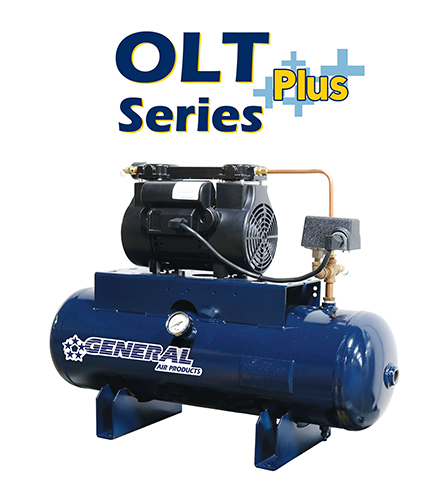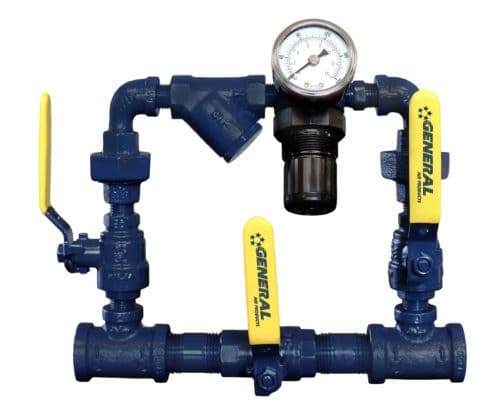Standard Pressure Air Compressors
General Air Products’ air compressors have two standard or factory pressure settings, depending on the type of compressor you select for your dry pipe system:

1.) Oil Less Air Compressors: After the initial system pressurization or fill, our OL & OLT Series air compressors are factory set to turn ON when the dry pipe system reaches 27 lbs. of pressure or psi (pounds per square inch) and turn OFF at 40 psi. The standard OL Series compressors can be adjusted to accommodate 50 psi maximum and 15 psi minimum settings.
Essentially you can set our standard compressors to 37 psi ON and 50 psi OFF at the highest end and 15 psi on and 30 psi off at the lowest end. You can adjust the compressor for any pressure in between as well as long as the pressure switch differential (difference between ON and OFF pressures) is a minimum of 13 psi.
2.) Lubricated Air Compressors: After the initial system pressurization or fill, our L & LT Series air compressors are factory set to turn ON when system pressure reaches 30 psi and OFF when the air compressor has brought the system up to 40 psi (an AMD-2, air maintenance device with pressure switch must be used to operate all L series air compressors). Our lubricated air compressors have a maximum pressure of 60 psi and the pressure switch on these units must maintain at least a 10 psi differential.
(Important Note: All of our air compressors can be field adjusted to fit the specific demands of the system you are working on. If you would like to field adjust your General Air Products air compressor to a setting other than the factory setting please call us at 800-345-8207 to have one of our fire protection air compressor experts walk you through the process.)
If your specific system requirements fall outside of the ranges described above you will need to select a compressor with a lower or higher pressure capability. Before we get into the capabilities of our low and high pressure air compressors for dry pipe sprinkler systems there is an important compressed air concept that needs to be understood:
Generally speaking, the higher the pressure capability of a particular horsepower air compressor, the lower the delivered air volume will be. Conversely, the lower the pressure capability of a particular horsepower air compressor, the higher the delivered air volume will be.
In practical terms this means that you will have to use a larger horsepower air compressor to pump up a high pressure system (60 + psi) than you would to fill that same system to standard pressure (40 psi). Conversely, pumping up a system to a lower than standard pressure allows a smaller horsepower compressor (and also a cost savings!) to be utilized. With this understanding we can get into more detail on low and high pressure versions of our air compressors.
Low Pressure Air Compressors
Low pressure air compressors are used when a dry pipe sprinkler system uses a high water to air ratio valve (typically 1 lbs. of air to every 8 lbs. of water). Currently Victaulic, Reliable and Tyco manufacture these high ratio valves. Low pressure air compressors can also be used on pre-action systems where the air is only used for supervisory purposes and up to 20 psi is required.
General Air Products offers a low pressure, oil less, riser mount air compressor (OL-LP Series). Our low pressure riser mount air compressors are designed and factory set to run at 13 psi and turn off at 18 psi. Click here to view the OL-LP Series Cut Sheet.
(Tip: You can save money by using a low pressure air compressor in a high ratio valve application as they are less expensive to use than the standard pressure air compressors because you can use a lower horsepower for the same system capacity.)
(Important Note: If a tank mounted unit is being used on a low pressure dry pipe sprinkler system a standard compressor should be used and the regulating to low pressure should be done with an AMD-1 air maintenance device. We can preset the AMD here at the factory at no charge.)
High Pressure Air Compressors
High pressure air compressors are typically used in dry pipe sprinkler systems when you have high city water pressure or where there is a fire pump forcing the air compressor to maintain over 37 psi to hold the valve and fill the system.
(Important Note: The pressure differential on our high pressure units’ pressure switches is 20 psi minimum.)
General Air Products offers high pressure air compressors in two types:
1.) Oil Less High Pressure Air Compressors (cut sheet here)
– Designated by adding “–HP” to the end of the model number
– Are factory set to turn ON when the system drops to 80 psi and OFF when the system reaches 100 psi. Keep in mind they can be adjusted to operate at lower pressure settings as long as the 20 psi differential is maintained.
2.) Lubricated Tank Mounted High Pressure Air Compressors (cut sheet here)
– Are also used when a customer wants to increase the amount of air stored in the tank.
– Designated by adding –HP to the end of the model number
– Are factory set to turn ON when the system drops to 80 psi and OFF when the system reaches 100 psi. Keep in mind they can be adjusted to operate at lower pressure settings as long as the 20 psi differential is maintained.
(Tip: It is always best to use a tank mounted air compressor when servicing a high pressure fire sprinkler system, then regulate the pressure down with an air maintenance device (our model AMD-1). A high pressure riser mounted unit can be used but we must caution that most dry valves are set for 65-70 psi max air pressure and that the minimum differential on the high pressure switch is 20 psi. So a normal setting would be 40 psi ON / 60 psi OFF (not compatible with the valve requirements).
If you would like to discuss your low pressure or high pressure air compressor questions and applications please contact our fire protection air compressor experts by emailing or calling 800-345-8207.
